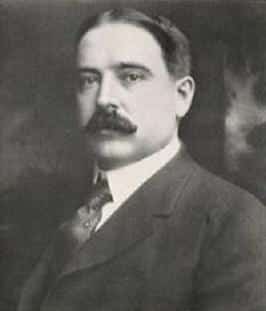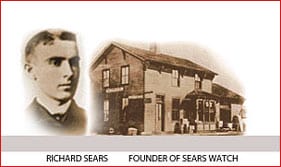Richard Warren Sears was born on December 7, 1863, in Stewartville, Minnesota. He was the son of James Warren and Eliza A. Sears, both of English ancestry. His father led anything but a happy life. He had failed in his quest for gold during the California Gold Rush of 1849 and was a bitter soldier in the Civil War, which he blamed on politicians.
He had earned a sizable sum of money working as a blacksmith and a wagon maker, but he lost it all in a stock-farm venture. Richard’s father gave up soon afterwards, leaving Richard to be the family breadwinner at the age of 16.
Richard worked in the general offices of the Minneapolis and St. Louis Railway in Minneapolis to support his family. He then decided to move Redwood Falls, Minnesota, where he thought that he could earn more money because of the small town setting. There he worked as a station attendant, doing chores for his board and sleeping in the loft of the railroad station. In his spare time, he learned how the mail-order business worked.
Richard got his opportunity to get into the mail-order business in 1886 when a shipment of watches from a Chicago wholesaler was refused by a town jeweler. Therefore, the shipment sat in the railroad station until Richard contacted the wholesaler, who offered him the watches for twelve dollars each.
He bought the watches and sold them by sending letters to other station attendants describing the watches and offering them at the discount price of fourteen dollars each. He sold those watches and ordered more to sell. To sell these he advertised in a small way in St. Paul newspapers. He made a large profit from this operation.
In a few months Richard made such a profit that he abandoned the railroad business entirely and started his own mail-order business under the name of the R.W. Sears Watch Company. In one year he made so much money that he was able to begin advertising in magazines with national circulation and move the business to Chicago.
On March 1, 1887, he set up a shop on Dearborn Street in Chicago with a staff of three people, one to handle bookkeeping and
correspondence and two stenographers. Soon after the opening of his new shop, he found a need for a watchmaker to repair watches returned by customers. This watchmaker was a young man by the name of Alvah Curtis Roebuck from Hammond, Indiana.
Richard Sears became even more successful by opening up the huge rural market. His advertising was aimed at the farmer, who was independent and stayed away from big companies. He portrayed himself to them as a fellow independent businessman, and was able to prove it by his low prices and his willingness to send watches on approval for just the payment of a deposit.
He was also able to succeed with farmers because he remembered life in small towns with great affection. Although he enjoyed his commercial success, he longed for the laid-back, small town way of life. In 1889, Richard sold the R.W. Sears Watch Company for $72,000 and moved to Iowa to enjoy the small town life.
Richard Sears would soon bore of his new life and decided to start a new company with his old business partner A.C. Roebuck. This new business was about the same as the previous one. It was a mail-order operation selling watches and jewelry under the name of A.C. Roebuck and Company. This new business was even more successful than the first, mostly because of its low prices and guarantee of satisfaction.
In September 1893, A.C. Roebuck and Company changed its name to Sears, Roebuck, and Company, the same name it carries today. Soon after, they moved the company to Chicago, where they could fill orders more easily to their major markets in Pennsylvania, Georgia, Texas, and Iowa. Later that year the first of the Sears catalogs that have become so familiar was made. The catalog was the key to the success of Sears. It used simple, direct language that spoke to the nation’s farmers. The catalog would claim that the goods featured inside were “the best in the world”.
The stress of this rapidly growing business was too much for Alvah Roebuck. Richard Sears would take several financial gambles that would eventually make the company prosper but would cause Roebuck to become uncomfortable. In August 1895 Roebuck sold his one-third interest to Sears for $25,000.
Although Roebuck decided to seek a quieter life, Sears had no intention of doing any such thing. He married Anna Lydia Meckstroth that year. She later gave Sears two sons and two daughters. His marriage and his growing family were all he needed to drive him to keep building his company.
Soon after the departure of Roebuck, Sears sold seven hundred shares of his company. Julius Rosenwald, a successful merchant of men’s suits who had done business with Sears in the past, and Aaron Nausbaum, who had been in business selling pneumatic tube systems, each purchased 350 shares. Sears would later sell 150 more shares of his company to each, giving the three each 500 shares.
Although the introduction of Rosenwald and Nausbaum did bring badly needed managerial skills to the company, it caused some problems. Nausbaum lacked the human touch which was so important to Sears. He was rough on the people who worked for the company, not hesitating to furlough them when he needed their paychecks to meet overdue bills. There was an obvious personality clash between the two which led to Sears and Rosenwald buying out Nausbaum’s interest in the company for $1.25 million.
Sears continued to prosper in rural markets, including the rapidly growing western frontier. This is because farmers in the West found the prices of merchandise too high at their local general store, whose prices were inflated due to several middlemen each taking a share as the goods moved from the manufacturer. Sears, on the other hand, was able to offer its goods at a lower price because he was the only middleman taking a share.
This utterly amazing growth caused problems for the company. The company would need more space and more markets to continue its growth. This also meant that the company would need more capital. This led to Rosenwald offering its stock to the public as a way to raise capital. In August 1906 some $9 million in preferred stock was offered. With the booming stock market, the public bought the stock eagerly.
While Rosenwald was putting their financial house in order, Sears had opened the company’s first branch mail-order plant. This plant was built in Dallas. The branch mail-order plant meant that the company could save money by ordering from local suppliers and avoiding considerable freight costs.
Sears and Rosenwald began to disagree on the path the company should take. This disagreement became even bigger during the depression of 1907, when the companies profits dropped by nearly a half-million dollars, the first such drop in company history. Sears wanted to increase advertising in order to increase sales while Rosenwald wished to trim expenses to weather the financial woes. Because Sears was in Europe at the time, Rosenwald’s approach to the depression was taken.
After the depression was over, Rosenwald’s approach had proven to be best. Sales remained steady and profits grew. This was enough to make Sears realize that times had changed since he started his company. Shortly afterwards, Sears resigned as president of the company and gave the position to Rosenwald. He then assumed the position of chairman of the board but resigned that position too soon afterwards. Richard Warren Sears died on September 28, 1914, in Waukesha, Wisconsin, at the age of 50.



Woah, this website is amazing.